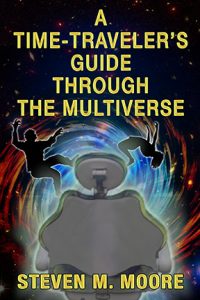Quantum mechanics and time travel…
“In the beginning, all the universes in the multiverse were only bubbles in the multiverse’s froth…if there was a beginning. Did God see it all and call it good but play a grand joke on us mortals just for kicks? Maybe the bubbles keep coming? I’ll never know the answer to that question, of course. No mere mortal can know. But there is a multiverse, and it’s filled with universes, quantum states of a unique universe, and mostly filled with stars…and delightful and dangerous weirdness.”

That’s physicist Gail Huff writing, and it’s how my new sci-fi novel A Time-Traveler’s Guide through the Multiverse begins (brought to you by Carrick Publishing). It’s a mishmash of hard sci-fi, mystery, romance, and humor that can be labeled a sci-fi rom-com. The romance and humor represent an experiment, a trek into genre terrain I haven’t visited before in my novels. The hard sci-fi is like all my science fiction, an extrapolation of known science into the future, getting weirder the farther it goes (in this case, multiple futures corresponding to multiple universes).
The major scientific theme, though, is quantum mechanics, not time travel, in particular the “Many Worlds Interpretation of Quantum Mechanics.” You see, quantum mechanics even today is still an elaborate cookbook of collected algorithms used to explain the invisible world of atoms, particles, and fields. It’s a witch’s brew without any satisfying interpretation of how it works. You pick an algorithm for each particular system, turn the crank, and presto gizmo—you have the quantum states. No one knows why it works, but it does…and is very accurate. Of course, most of the systems are sufficiently complex that we solve the associated problems with a computer, making it all the more algorithmic. (Like everything else in physics these days, the easy problems have already been solved!)
Most physicists don’t spend any time on the problem of interpreting the quantum algorithms—they just turn the cranks like the monkeys writing Shakespeare. It’s easier laziness or an admission of defeat, because these physicists say it’s a waste of time to look for a sound interpretation of this mysterious theory. To be fair, some have spent time on making the cranks easier to turn. (Feynman’s approach to quantum electrodynamics is a famous example, although its accuracy achieved by throwing out the right infinities just adds to the mystery.) However, most practicing physicists are like prehistoric shamans chanting the quantum rules in the hope that their mumbo-jumbo bears fruit in their calculations.
The NY Times recently had an article about work done on the interpretation of quantum mechanics, though, where an electron, for example, is just a messy glop spread out in space and time (I add the latter, often just considered a parameter, because an interpretation of quantum mechanics must eventually consider the time dimension in order to make it applicable and compatible with general relativity). In defense of the Times, their article was a biopic about the crazy physicist who postulated this gooey interpretation of quantum mechanics. In doing so, the newspaper ignored many other different failures to interpret quantum mechanics over the years (Bohm’s theory, stochastic electrodynamics, etc.).
Hugh Everett II, who later was clever enough to become rich by starting a “beltway bandit” that fed off Pentagon largess, created the “Many Worlds Interpretation” in his Princeton thesis written under the guidance of John Wheeler (the latter coined the term “black hole” and was the same guy who served as PhD adviser for Richard Feynman). It’s easy to express his idea: Quantum mechanics (QM) is really a theory of histories. Each electron has a bundle of associated histories, with each history described by an associated probability for its position at each time considered (in non-relativistic QM, the wave function Ψ). This probability is the magnitude-squared of the complex quantum state (ΨΨ*). When we “observe” an electron, we latch onto one of its possible histories.
Each physical system has a bundle of histories, each system of systems, a combined history, and so forth. In particular, our universe is a system of many systems, so there is one huge combined history. The multiverse is all possible histories of the universe, so you can consider each one of its quantum histories to be another universe. The question my novel addresses is: Can you somehow hop between them?
If that blows your mind, you should enjoy my main characters’ time-traveling adventures. You already understand all you need of the physics (or lack thereof) lurking in the background. Be assured it’s a lot cleaner that the gooey mess discussed in that NY Times article! It also avoids all the paradoxes most time-travel novels contain. (Gail recognizes early on that her assistant will never be the time-traveler’s husband back from some earlier epoch.) Those paradoxes represent why I’ve written few time-travel stories, but I’ve now avoided them. To find out more details, you’ll have to read the novel, of course. Get ready for some fun laughing at stodgy old physicists who’ve spent their whole lives turning the cranks!
Let me add that there are many other interpretations of QM in the research literature than the one in the Times’s article and the one considered here. Maybe we should call them all “interpretation histories” of the “interpreverse”?
[Note from Steve: The first part of this novel is based on my short story “The Apprentice.” You will find it in the blog category “Steve’s Shorts” or in either Pasodobles Two or Three (I can’t remember which one, but you can download both for free–see the list on the “Free Stuff & Contests” web page).]
***

Comments are always welcome!
Binge-reading #3. While I’m binge-reading other authors’ series, you’re welcome to binge on mine. In the “Esther Brookstone Art Detective” series, Esther, a Scotland Yard inspector in the Art and Antiques Division, obsesses with recovering a Rembrandt stolen by the Nazis in WWII (Rembrandt’s Angel) and with finding St. John the Divine’s before others do (Son of Thunder). Interpol agent Bastiann van Coevorden tries to keep her on an even keel. You might not consider this series binge-worthy—there are only two books so far (#3 is in the works)—but there’s a lot of fun reading here. Available on Amazon and at the publisher’s website, as well as on Smashwords and at its affiliated retailers (iBooks, B&N, Kobo, etc.) and library and lending services (Scribd, Overdrive, Baker & Taylor, Gardners, etc.). Enjoy!
Around the world and to the stars! In libris libertas!
